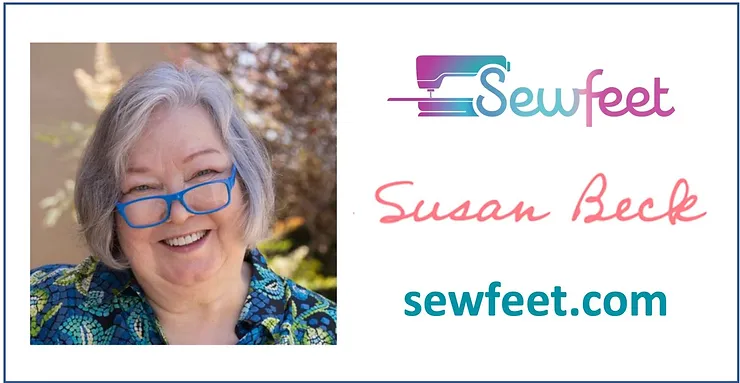Hi, I’m Susan from Sewfeet.com and today’s post is about what happens inside your projects as you create them. I’m going to focus on one type of material, which is interlining, but first, let’s look at two additional materials that are similar but used for different purposes. Even the names of all of them are somewhat similar and it can be confusing to keep them straight. The interlinings in this post are distributed by RNK Distributing and I’ve made a FREE Printable that gives you the details at a glance so you can easily decide what you need for your next quilted project.

Interfacing
First, there is interfacing, which is a layer of material that is placed on the wrong side of your main fabric. It is often used for garment sewing to add body and support to certain parts of the garment. It comes in two types, woven and non-woven, and each of those are available in sew-in and fusible options. Interfacings come in different weights so you can add light or heavy weight support as needed. It is mostly used in areas that need some shape and support, such as collars, cuffs, and jacket openings. It is always used in an area where you plan to stitch buttonholes.
Lining
Next, let’s talk about lining. It is a separate fabric, stitched to the edges of a garment with right sides together. When the fabrics are turned so the right sides are out, the lining hangs loose in most garments such as jackets and coats. Lining fabric is typically very lightweight, so it doesn’t add bulk to the project. And it is often a slippery material that makes it easy to slide the garment on and off. A garment (usually jackets and coats) may have both interfacing and lining. Other projects such as purses, totes, and zippered pouches are often lined but the fabrics used are usually similar to the outer fabric, such as quilting cotton.
Interlining
And third, interlining, is another layer that can be used to add support to your fabric. It also fuses to the wrong side of the fabric. There are several reasons to use interlining for your project. If you have a limp, lightweight fabric when you need something with more body, interlining may help. You simply fuse or sew it to the wrong side of the fabric and then treat the two layers as one piece of fabric. You can do this after you have cut out the pieces of your project, but an easier way is to fuse the interlining to the uncut fabric, and then cut out the pieces. Interlining can make your fabric stronger and more durable, and in some cases, it can make your garment warmer, and it can let you shape the fabric as needed to suit your project. All of these depend on the type of interlining you use. RNK Distributing has several types of interlining used for different purposes.
Interlining
Designed to be used for fabrics that easily ravel or pucker as you stitch. It has a permanent bond but is very lightweight, so it doesn’t add bulk to your fabric. It has a soft woven texture and does not change the drape of the fabric to which is fused. Fuse it on the wrong side of the fabric using a silk setting on your iron.

Floriani Dream Weave
This interlining comes in three versions, Dream Weave Fusible, Dream Weave Ultra, and Dream Weave Supreme. They are used for delicate fabrics such as silk, satin, lame or chamois. The fragile fibers of these types of fabric cannot handle the high speed and constant needle penetration during the embroidery process. By fusing Floriani Dream Weave Fusible to the back of the fabric, it protects the fabric by giving it more body, yet doesn’t change the weight or drape of the fabric. This can also occur in fabrics such as Swiss Batiste, top quality quilt cottons and linen, or spandex which are often used in dance uniforms and bathing suits. Dream Weave Interlinings are also used as a lining in all types of fabrics for suits or garment construction.

Floriani Dream Weave
This iron-on, nonwoven foundation material is different from typical interlinings. Deco Magic is a leather-like product is easy to shape and is tear-resistant. Fuse it to the wrong side of your favorite fabric to create a dimensionally stable, yet flexible material for making hats, bags/purses, belts, fabric bowls, crafting, and home-dec projects. The fusible adhesive on Deco-Magic creates a permanent bond to the fabric but because the adhesive is needle-friendly you can embellish with your favorite decorative stitches or embroidery designs. Deco Magic is available in regular and light-weight versions.

I recently made a fabric tray using Deco Magic and I love how it gives structure and body to it. CLICK HERE for instructions to make this fabric tray.
Don’t forget to down the FREE Printable on RNK Interlinings. RNK Distributing is a wholesale distributor of sewing and quilting products that include the ones discussed in this blog posts. Go to RNKDistributing.com to find a retailer near you.
For more information from and about Susan, visit her at Sewfeet.com.

